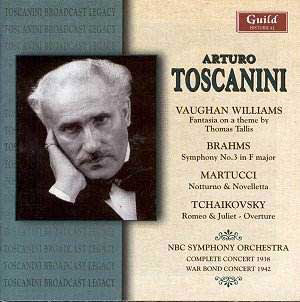More live Toscanini from Guild. The bulk of this double
set derives from one of the weekly concerts of the NBC Symphony Orchestra
and given on 15 October 1938. There are also two pieces from a War Bond
concert of 1942, the Bach and Haydn. Toscanini had worked with the NBC
for less than a year when he was recorded – all the NBC broadcast concerts
were recorded – in repertoire both congenial and unfamiliar and one
of the most enticing prospects is to hear Toscanini conducting the Tallis
Fantasia. It’s a performance of strong profile from its firm opening
pizzicati onwards, with surging and expressive violins but not over
opulent. Sometimes the syntax isn’t as seamless as it should be and
some of the entry points are quite vigorously attacked – a distinct
lack of piety pervades the performance and that’s no bad thing once
in a while. What is less convincing is the theatricality of the pause
at 9’26 – and the exaggerated and all-too-rehearsed dynamics at the
close. There is some flutter at 11’00 onwards and some hum but it’s
a minor problem and never obscures the interest of a performance which,
though often impressive, fails to ignite from within. His way with Brahms
is charted territory. Opening with elegant fluency and powerful momentum
the andante receives a performance of freshness and dramatic unity,
free flowing and cohesive and far superior to his 1952 recording. The
string playing is especially attractive in the third movement though
perhaps I am alone in finding the practised clip of Toscanini here rather
too predictable. Crisp trumpets animate the finale at once vigorous
and animated.
The two Martucci sweetmeats were orchestrated from
piano pieces. Notturno is a succulent pastoral and Novelletta is wittily
pointed by Toscanini, giving sly rein to the dotted horn figure. Romeo
and Juliet opens with an atmospheric paragraph of real anticipatory
drama – much more so than I was expecting. Sleeve note writer William
Youngren notes that Toscanini’s performance is animated by "relative
continuity of tempo" which may be true but ignores the rather incendiary
aspects of this performance which render it problematic. The Battle
music is violently fractious and it is, I think, very much a matter
of taste as to whether the scale of the piece is properly maintained.
The conclusion, with its dramatic drum roll is precipitate, rushed and
the coda generally splashy and unconvincing, whatever its dramatically
tragic implications. The 1942 Concert has an attractive Bach Air and
a less attractive Haydn Symphony. It’s all a little big and blatant,
lacking in the flecks of discernment and lightening that animate better
performances. Toscanini was generally a fine Haydn conductor but this
is not one of his most rewarding recordings.
Jonathan Woolf


